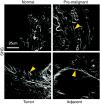Remodeling and homeostasis of the extracellular matrix: implications for fibrotic diseases and cancer
- PMID: 21324931
- PMCID: PMC3046088
- DOI: 10.1242/dmm.004077
Remodeling and homeostasis of the extracellular matrix: implications for fibrotic diseases and cancer
Abstract
Dynamic remodeling of the extracellular matrix (ECM) is essential for development, wound healing and normal organ homeostasis. Life-threatening pathological conditions arise when ECM remodeling becomes excessive or uncontrolled. In this Perspective, we focus on how ECM remodeling contributes to fibrotic diseases and cancer, which both present challenging obstacles with respect to clinical treatment, to illustrate the importance and complexity of cell-ECM interactions in the pathogenesis of these conditions. Fibrotic diseases, which include pulmonary fibrosis, systemic sclerosis, liver cirrhosis and cardiovascular disease, account for over 45% of deaths in the developed world. ECM remodeling is also crucial for tumor malignancy and metastatic progression, which ultimately cause over 90% of deaths from cancer. Here, we discuss current methodologies and models for understanding and quantifying the impact of environmental cues provided by the ECM on disease progression, and how improving our understanding of ECM remodeling in these pathological conditions is crucial for uncovering novel therapeutic targets and treatment strategies. This can only be achieved through the use of appropriate in vitro and in vivo models to mimic disease, and with technologies that enable accurate monitoring, imaging and quantification of the ECM.
Figures





References
-
- Abraham D. J., Varga J. (2005). Scleroderma: from cell and molecular mechanisms to disease models. Trends Immunol. 26, 587–595 - PubMed
Publication types
MeSH terms
Grants and funding
LinkOut - more resources
Full Text Sources
Other Literature Sources
Medical

